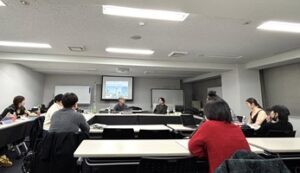【Event Report 】Hosei University Research Center for International Japanese Studies Transnational Japan Workshop Series(5) Politics of “Kuki” and Transnationality January 16th, 20252025/02/20
Hosei University Research Center for International Japanese Studies
Transnational Japan Workshop Series(5)
Politics of “Kuki” and Transnationality
「空気」の政治とトランスナショナリティ
■ Date/Time: January 16th (Thu), 2025 17:30~19:30
■ Location: Hosei University Ichigaya Campus, Shin Mitsuke Building, 3rd FL, Room A 305 (Face-to-face format)
■ Presenters:
Christophe Thouny (Ritsumeikan University)
Kei Takata (Hosei University)
The Hosei University Research Center for International Japanese Studies has been hosting a series of workshops titled “Transnational Japanese Studies.” For our fifth event, we organized a workshop on the theme of “The Politics of ‘Kūki’ and Transnationality” to explore Japanese communication of “kūki (空気).” What exactly is “kūki”? Is it a “good” thing or a “bad” thing? Amid growing diversity and transnationalism, can there be a mode of communication that replaces “kūki?” We discussed these questions through presentations by Kei Takata and Christophe Thouny, followed by extensive discussions with the floor.
The first presenter, Kei Takata of Hosei University, traced the evolution of the image of “kūki” over the past 20 years. In his presentation titled “Transition of ‘kūki’ Image,” he thoroughly analyzed publications discussing “kūki” from a cultural sociological perspective and revealed that it was not until the early 2000s that “kūki” communication began to gain attention. According to his analysis, books on “kūki” can be divided into three periods: the first from 2004 to 2010, the second from 2011 to 2017, and the third from 2018 to 2024. The presentation examined the number of books published, the characteristics of the authors, and the content of the books, demonstrating that there was a significant shift in how “kūki” communication was addressed from the first to the third period; the image transformed dramatically from a positive to a negative form of communication within a decade. The presentation argued that this shift in the image of “kūki” was influenced by various social events that occurred during the second period, such as the Great East Japan Earthquake, the emphasis on (neuro) diversity, the political scandal involving “sontaku (忖度)” within the Liberal Democratic Party, the “Work Style Reform,” and pandemics, among others.
The next presentation by Christophe Thouny of Ritsumeikan University offered various ideas that provide insights into understanding “kūki.” First, he highlighted the internal difference to urban “kūki,” the desired opposition between the city and the country, referencing the Norio Nagayama case in 1968 and the Sakakibaraseito incident in 1997, based on Munesuke Mita’s analysis. He also challenged the conventional belief that “kūki” and “seken (世間)” are remnants of feudal culture. Thouny argued that “kūki” should not be viewed as something linear that can be transcended by modernization and rationality, but rather as a form of nonsynchronism (Ernst Bloch) that is continuously recalled. He also referred to KY-fascism and its connection to the Japanese owarai comedy culture that has gained prominence, particularly since the 2000s. Finally, through the introduction of Hirokazu Kore-eda’s film “Air Dolls,” he emphasized the potential for “kūki” to be something positive. Since “kūki (空気)” is “empty (空っぽ),” it holds the potential to foster connections among people.
After these presentations, a discussion with the audience followed. Since “kūki” is nearly unavoidable for Japanese speakers, many questions and comments were raised by participants based on their expertise and experience. For instance, participants asked, “Why has the discussion on ‘kūki’ gained momentum since the 2000s?” Takata responded that “kūki” was a fundamental aspect of communication in Japanese corporate culture during the rapid growth period and hypothesized that “kūki” has paradoxically garnered attention from the early 2000s precisely because “kūki” communication has entered a crisis alongside the transition of Japanese capitalism. Many non-Japanese native speakers participated in the workshop, and discussions also extended to the challenging nature of “kūki” communication in a transnational context. In response to the issue of non-Japanese natives being inherently excluded from “kūki” as it is a homogeneous and high-context form of communication, there was a discussion about whether the “democratization of ‘kūki’” is feasible. However, it was also noted that “kūki” communication is a serious issue for Japanese native speakers as well. Yasuko Yokoyama (Hosei University) mentioned that many Japanese university students she encountered also struggle with “kūki” communication. She added that it is not only the pressure to conform to “kūki,” but what is even more troubling is that they do not see any alternatives to replace “kūki” communication.
Such a vibrant discussion reaffirmed that “kūki” is a key concept when considering contemporary Japanese society. This time, we intentionally avoided defining what “kūki” is and instead focused on the various ways it has been discussed. One intriguing aspect of the term “kūki” is its potential for diverse interpretations. However, it would also be beneficial for future research to narrow down the concept regarding its versatility, the range that “kūki” encompasses, the normativity of “good” and “bad,” and the universality and uniqueness of its cultural characteristics.
Kei Takata (Hosei University)


